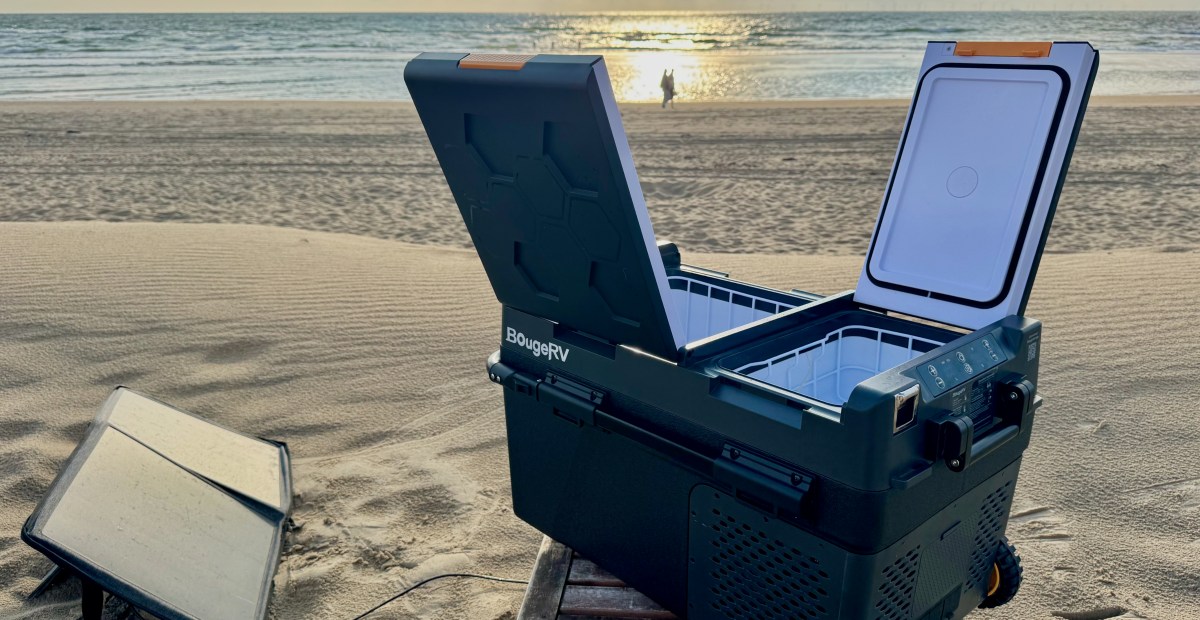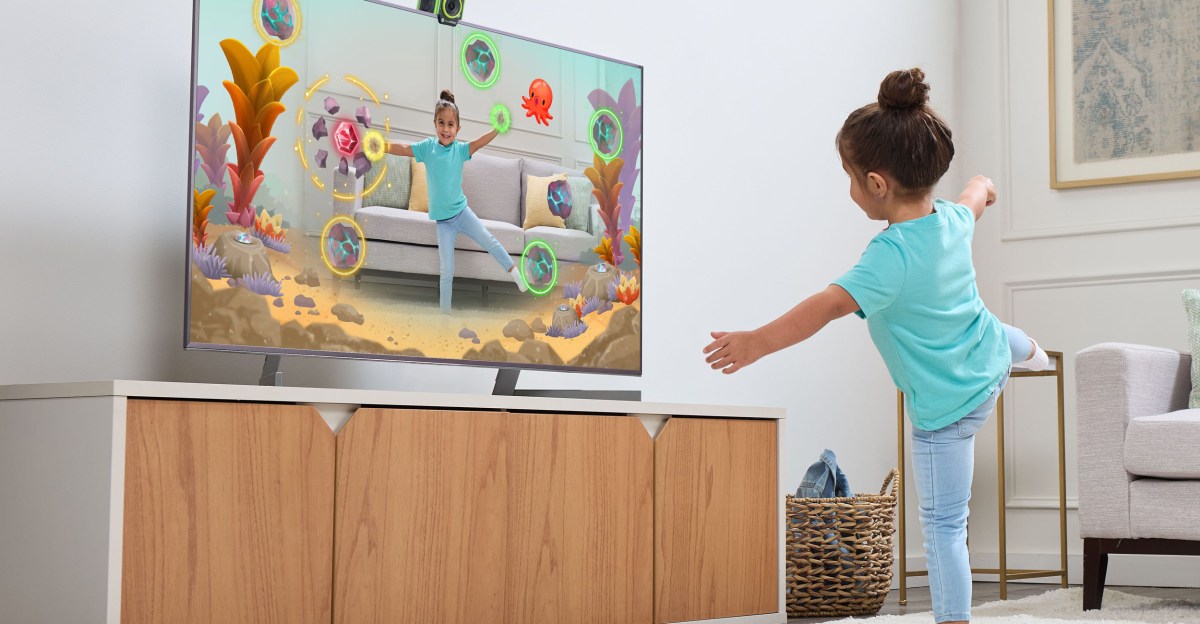Keeping humans alive at home in post-agrarian societies requires refrigeration. Meat bags on the move must either load up a cooler with ice for a soggy weekend barbecue or do the evolved thing and use a 12V fridge instead.
Latest Tech News
BougeRV’s portable solar fridge is quietly annoying

The $509.99 battery-powered BougeRV CRD2 40 refrigerator and freezer combo I’ve been testing for the last few weeks runs for almost 12 hours on its itty-bitty battery. It charges from a wall outlet or a 12V socket found in cars and portable power stations. It even accepts 100W of direct solar input to stay charged in sunny climates. And if this 40-liter (43-quart) model is too small, it’s also available in larger 49-liter and 58-liter capacities.
BougeRV gets the basics right, but with lots of little annoyances along the way.
The CRD2 40 is what you choose when rugged portability is a must. It can easily fit inside a boat, RV, or the trunk or backseat of a car and features lots of tie-down points to keep the 28.7 x 18.14 x 17.24in (730 x 461 x 438mm) fridge from becoming a 41.9lb (19kg) projectile. And once you arrive, it can be moved about with help from its spring-loaded side handles, telescoping arm, and chunky wheels.
Importantly, the two cooling compartments — one large (32.5 liters) and one small (7.2 liters) — are covered by a pair of doors that can be reversed for easy opening from either side. This adaptability is fantastic for vanlifers or anyone else with limited space for such a large appliance.
And because it doesn’t try to do too much — unlike EcoFlow and Bluetti’s 3-in-1 ice-making fridges — BougeRV’s combo unit maximizes available capacity for food and beverages. Even the smaller CRD2 40 fits a lot; enough for me and my wife to stay away from the grid comfortably for about a week when using the large compartment as a fridge and the small space as a freezer.
I did all my testing at FDA-recommended temperatures of -18 degrees Celsius (0 degrees Fahrenheit) for the freezer and 4C (39F) for the fridge. Cooldown from room temperature of 22C (72F) to 4C took 17 minutes for the small compartment, or 37 minutes for the large. It took 79 minutes to bring the small space down to -18C and 101 minutes for the large side. That’s pretty slow, but the CRD2 40 is also reasonably quiet.
At its loudest, I measured 38dB during cooldown making it about as loud as a small home theater projector. That’s far below the 45dB BougeRV quotes on the spec sheet (perhaps the larger CRD2 models are noisier?) and quieter than other combo fridges in this space. While there was the occasional audible whoosh of liquid, it otherwise didn’t emit any odd gurgles or scratching sounds I’ve heard from other portable fridges. The compressor turns on and off every 10 minutes or so with a slight rattle and then runs for 10 minutes to maintain the temperature.
The fully charged 173Wh battery lasted 11.5 hours when running in the most economical modes, so long as the compartments were cooled down to -18C/4C ahead of time. That runtime dropped to just six hours when the battery had to start at room temperature. That’s not particularly efficient, and likely has to do with BougeRV skimping on insulation.
For my insulation test, I brought the large compartment down to -18C and shut off the power. After one hour, it already read -4C, 0C after an hour and a half, and 10C at three hours in a room reading 22C. I never opened the lid. That’s not very good compared to other portable fridges and suggests that this fridge will have to work hard in warmer climates to keep your food safe.
Temperature readings on the BougeRV display and app were consistent with my reference thermometer in the smaller compartment. However, my thermometer read -14C, not the -18C reported by BougeRV, when placed at the bottom of the large compartment. This likely has to do with BougeRV’s sensor placement and the poor air circulation that’s typical of this class of fridges.
So, BougeRV gets all the important things right, but I was disappointed by the company’s inattention to detail and general lack of care.
For starters, the simplistic Bluetooth app labels the two compartments “L” and “R” (left and right?) instead of “L” and “S” for large and small, like you see printed on the fridge. It also lacks precision when reporting the battery percentage, showing five of five bars, for example, when the LED display on the battery itself only shows two of four LEDs, or about 50 percent charged.
And get this: the instruction booklet warns that “due to different production batches, you may receive a battery with or without a Type-C connector.” WHAT?! My review unit arrived with a battery fitted with a little barrel, not the preferred USB-C jack. That means it can only be charged inside the fridge itself since I didn’t receive a compatible charger in the box. Oh, and the logo on the battery is upside-down which makes insertion confusing. Come on.
Annoyingly, solar charging requires a 5521 barrel connector, not the more common XT60 jack. I didn’t have the correct 100W solar panel to test with the fridge, but BougeRV will happily sell you a bundle that includes a compatible panel for $663.99.
More worrisome is the peculiar behavior I observed when the battery was almost fully discharged. In the last hour or so before the battery died, the temperature of the freezer dipped way below the -18C temperature I had set. It read -22C on the physical display, but my own thermometer dropped all the way down to -29C. At first, I thought it might be another case of a bad sensor like the one that plagued some older EcoFlow fridges. But plugging the fridge back in caused the temperature to quickly retreat to -18C, and I haven’t seen any issues since. Weird. BougeRV didn’t have an explanation ready in time for this review. The fridge is covered by a two-year warranty.
Sleeping near the BougeRV fridge — as vanlifers and drunken fishermen are apt to do — is also a mixed bag. On one hand, it’s reasonably quiet. However, it will beep a few times if it loses Bluetooth connection. This has already woken me up twice despite my phone being nearby the fridge. The display is also very bright in a dark room and there’s no way to dim it or turn it off.
1/19
Even with all my gripes, BougeRV’s $509.99 CRD2 40 with battery bundle makes for a fine travel companion, especially in the highly portable 40-liter (43-quart) size I reviewed. However, I’d avoid the battery-less model priced at $349.99 because you can easily find a more compact and less expensive combo fridge that can be permanently plugged into a 12V power source at a fixed location. You buy the CRD2 40 because you’re looking for adventure, and maybe just a taste of self-flagellation.
Photography by Thomas Ricker / The Verge
Latest Tech News
The LeapMove is a gamified camera designed to get kids off the couch

LeapFrog has announced a new electronic learning system that swaps controllers for a camera. In fact, the LeapMove looks like an oversized, kid-friendly webcam, but is designed to connect to TVs like a console and get kids off the couch using educational games that require full-body movements to play. It’s reminiscent of the Xbox Kinect or the PlayStation 2’s EyeToy, but simpler and much cheaper than competitors’ products like the $249 Nex Playground.
The LeapMove will be available through retailers including Target, Walmart, and Amazon for $69.99, and comes with 25 motion-based games designed for kids aged 4 to 7. It might be hard to pull the older end of that demographic away from games like Roblox, Among Us, and even Fortnite, but in addition to motion detection, the LeapMove uses its camera to make players appear as themselves or “whimsical characters” in several games, which may appeal to younger kids.
The games cover “foundational school subjects” including math, reading, and spelling, and require players to do everything from dancing around to waving their arms and even attempting to catch on-screen objects. The LeapMove connects to a TV over HDMI, and instead of rechargeable batteries it needs access to a power outlet. It can be used either sitting beneath a TV or perched atop it like a webcam using a fold-out support.
LeapFrog says additional games will be made available for the LeapMove at a later date, which can be loaded by connecting the device to a computer and using the company’s LeapFrog Connect desktop app. They won’t be free, but unlike the Nex Playground, the LeapMove doesn’t come with any subscription fees.
Parents concerned about privacy, particularly with devices that rely heavily on a camera, may appreciate that the LeapMove has no wireless connectivity. In 2018, VTech, LeapFrog’s parent company, agreed to settle for a $650,000 fine after the FTC alleged it collected kids’ personal information, including names, emails, and genders, through its KidiConnect mobile app. The LeapMove is completely standalone and keeps track of up to three players’ progress locally.
Latest Tech News
Meta is playing the AI game with house money

Mark Zuckerberg’s AI hiring spree is costing a lot of money. His investors don’t care.
Meta’s stock price shot up over 10 percent on Wednesday after the company reported better-than-expected earnings. Revenue generated in the second quarter was $47.5 billion, up 22 percent from a year ago. Daily users across Facebook, Instagram, Threads, and WhatsApp grew to almost 3.5 billion. Meta also warned Wall Street that it would spend more on data centers and hiring next year. In response to all this, the company’s valuation increased by over $175 billion, or more than 12 Scale AI deals.
”Our business continues to perform very well, which enables us to invest heavily in our AI efforts,” Zuckerberg said during today’s earnings call. Meta’s cash cannon is now fully pointed at his new moonshot of achieving superintelligence, or as he puts it, AI that “surpasses human intelligence in every way.” He bragged about providing the richly compensated members of his new superintelligence lab “access to unparalleled compute” for training new models that will “push the next frontier in a year or so.”
Zuckerberg’s last moonshot was the metaverse, which came up only once at the very end of today’s earnings call. It’s too early to compare the two projects, but they share a key similarity: they need the kind of funding that only a company like Meta can provide.
Where AI differs from the metaverse, however, is that it appears to be already improving Meta’s ads business. A new AI model for delivering ads has driven approximately five percent more conversions on Facebook and three percent more conversions on Instagram, according to CFO Susan Li. Large language models are also starting to power how posts are ranked in feeds across the company’s apps, including Threads.
While Meta is still spending heavily on the metaverse (it’s on track to spend a total of $100 billion on its Reality Labs division this year), there’s no mistaking the fact that AI is officially Zuckerberg’s top priority. This time, though, he’s playing catch-up in a heated race, not trying to invent a new platform from scratch. The stakes are much higher, even if he’s playing the game with house money.
Latest Tech News
YouTube tells creators they can drop more F-bombs

YouTube videos with strong profanity in the first seven seconds (words like “fuck”) are now eligible for full monetization, according to a video from Conor Kavanagh, YouTube’s head of monetization policy experience. Previously, these kinds of videos were only eligible for “limited ad revenue.”
Changes to YouTube’s inappropriate language policies have long been a sore spot for creators. In November 2022, the company began to potentially limit ad revenue if profanity was used in the first 8–15 seconds of a video. ProZD, whose real name is SungWon Cho, published a video where, after waiting 15 seconds, he called the policy change “the dumbest fucking shit I’ve ever heard.” (He later said that the video was demonetized.) YouTube adjusted its policies in March 2023, including allowing videos with profanity in the first 8–15 seconds to be eligible for ad revenue.
I asked ProZD his thoughts about Tuesday’s change. “It’s about fucking time.”
The company originally restricted monetization for videos with swearing at the start of videos to “align with broadcast standards,” Kavanagh says. “Advertisers expected ads on YouTube to have distance between profanity and the ad that just served.” However, “those expectations have changed,” he says, “and advertisers already have the ability to target content to their desired level of profanity.”
While the only specific example of “strong” profanity Kavanagh provides is “fuck” — he says that YouTube defines “moderate profanity” as words like “asshole” or “bitch” — “you get the idea,” he says.
YouTube will continue to limit monetization if you use moderate or strong profanity in titles or thumbnails. Videos with a “high frequency” of strong profanity are also still a “violation” of YouTube’s advertiser-friendly content guidelines, Kavanagh says. “You have to pick and choose your fucks carefully.”

 Fintech2 weeks ago
Fintech2 weeks agoOpenAI and UK Government Partner on AI Infrastructure and Deployment

 Latest Tech News2 weeks ago
Latest Tech News2 weeks agoThe tech that the US Post Office gave us

 Cyber Security2 weeks ago
Cyber Security2 weeks agoMicrosoft Fix Targets Attacks on SharePoint Zero-Day – Krebs on Security

 Latest Tech News1 week ago
Latest Tech News1 week agoTrump wanted to break up Nvidia — but then its CEO won him over

 Artificial Intelligence2 weeks ago
Artificial Intelligence2 weeks agoApple loses key AI leader to Meta

 Latest Tech News1 week ago
Latest Tech News1 week agoGPD’s monster Strix Halo handheld requires a battery ‘backpack’ or a 180W charger

 Cyber Security1 week ago
Cyber Security1 week agoPhishers Target Aviation Execs to Scam Customers – Krebs on Security

 Artificial Intelligence1 week ago
Artificial Intelligence1 week agoGoogle’s newest Gemini 2.5 model aims for ‘intelligence per dollar’























